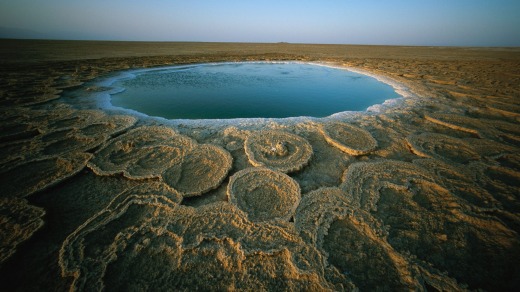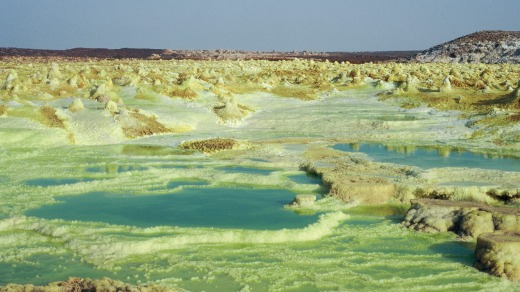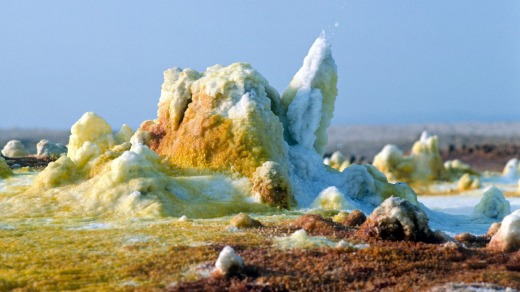The Danakil Depression, in northern Ethiopia, is one of the hottest and least hospitable places on earth. It's also awesome. Video: Colin Cosier
Patrick Hatch discovers lava pits, plains of nothingness and otherworldly rock formations in the hottest place on earth.
"Destroy the ring Mr Frodo! Throw it in the fire!" I can't help but yell.
Staring into the bubbling lava pit of Erta Ale, one of the world's few constantly active volcanos, it's hard not to think of Sam and Frodo's adventure into the belly of Mordor in Lord of the Rings.

The Danakil Depression, in northern Ethiopia, is one of the hottest and least hospitable places on earth.
Four days here, where the average year-round temperature is a world-topping 34.4 degrees and the mercury frequently tips 50, pushes the body and its sense to the limit.
We start in Mekele, a bustling town about 700 kilometres north of the capital Addis Ababa and meet our tour group – the only legal way to visit the Danakil.

From Mekele we head north in a convoy of about a dozen four wheel drives, winding up and down steep hills and past golden fields of teff, the grain from which Ethiopia's ubiquitous flat bread injera is made.
About midday, hills give way to an unending flatness and the fields are replaced with thick slabs of crumbly black volcanic rock.
Our guide cheerfully describes the road from here to Erta Ale – smoking mountain in the local tongue – as "probably the worst in the world".

In truth, he's being generous calling it a road at all.
The air-conditioned 4WD's thermometer reads 40 degrees, in the sun it feels like 50, and our sweating bodies jar and snap as we bounce across the rocky landscape.
Two hours later our aching limbs and throbbing heads beg for it to be over and at this point, any village on earth would be a welcome sight.
So our disappointment arriving in Dodom, at the volcano's base, tells you everything you need to know about Dodom.
The few dozen Ethiopian soldiers who live in slapped-together rock huts here forgo sanitation, running water, entertainment and shade.
It's hard to imagine what grave act of insubordination they committed to deserve this posting.
The rag-tag battalion and their rusty AK-47s are here to guard the border with arch-foe Eritrea, which Ethiopia last went to war with in 2000.
They're also here to keep an eye on us tourists, after the Afar Revolutionary Democratic Unity Front – who wish to unite Afar people from both sides of the border – killed five tourists and kidnapped four others at the volcano's rim in 2012.
The sun goes down and we begin the three-hour scramble up the volcano, its lava pit glowing on the horizon.
We think we know the limits of our senses: the loudest sound we can hear, the sweetest thing we can taste.
But staring into the fiery pit, 60 metres across, the boundary of what I thought my eyes could process are redrawn.
The lava is brighter, redder and more retina-burningly brilliant than anything I have seen.
It bubbles ferociously then cools into a crust. Pressure builds underneath until lava bursts into the sky in a blazing molten geyser as terrifying as it is spectacular.
After an hour staring into the fiery abyss, our military chaperones drag us away to a rocky shelf where we sleep under the stars.
After such a sensory onslaught, the next day we veer across the desert towards Lake Asale, where nature provides the perfect antidote for our battered faculties.
At sunset we drive out to the massive salt lake, where the clear sky meets the endless white plains surrounding the shallow lake.
The horizon and ground beneath our feet blend into one dream-like space, silent and lifeless; a landscape defined by nothingness and occupied only by visitors.
Or at least it felt that way. A few kilometres from here, we catch our first glimpse of what must surely be the toughest men on the planet.
The caravan of 20 or so camels come into vision first, plodding stoically in single file. Then, their owners: hard faced and muscular, red-chequered turbans their only protection from the extreme elements.
Danakil salt miners walk for weeks into the hottest place on earth to hunch over in the blazing sun and hack slabs of course salt from the ground.
We watch in disbelief as they carve the salt into neat, five-kilogram blocks and load them onto the back of waiting camels, forever changing my definition of "hard yakka" in the process.
Senses cleansed, and with new appreciation of my desk job, we are ready for the Dallol sulphur fields, where the earth is at its most creative.
Here, sulphur bubbles up from deep below the earth, bringing minerals with it to build colourful and otherworldly rock formations.
Sulphuric acid fizzes in pools of green and aqua blue rock, punctuated by jagged yellow peaks, like an aboveground coral reef.
The pungent air makes me feel lightheaded and I stagger around this psychedelic landscape in a daze.
Our guide soon straightens me up with a warning of how a couple of years ago a guide and an American tourist ventured onto thin parts of the rocky crust and fell through and suffered horrific acid burns.
We make it back to the 4WDs in one piece and start the long slog back to Mekele, made bearable only by the promise of a shower when we get there.
TOURING THERE
A number of companies run tours to the Danakil Depression, which is the only way tourists can visit the area
Ethio Travel and Tours, [email protected], +251936010968, has tours leaving from Mekele every second day.
The Addis Ababa-based company strikes a good balance between professionalism and price and can also arrange internal flights.
GETTING THERE
Emirates flies from Australia to Ethiopia's capital Addis Ababa via Dubai.
From there, Ethiopian Airlines, www.ethiopianairlines.com, flies daily to Mekele.
The flight is only an hour, but the journey from the capital takes days by road.
STAYING THERE
All tours to the Danakil include accommodation, although it's sometimes just a bamboo stretcher bed under the stars.
SAFETY
Note that the Australian Federal Government currently advises that travellers should reconsider their need to travel to Ethiopia and currently have a 'Do not travel' warning for the Danakil area. See http://smartraveller.gov.au/countries/ethiopia